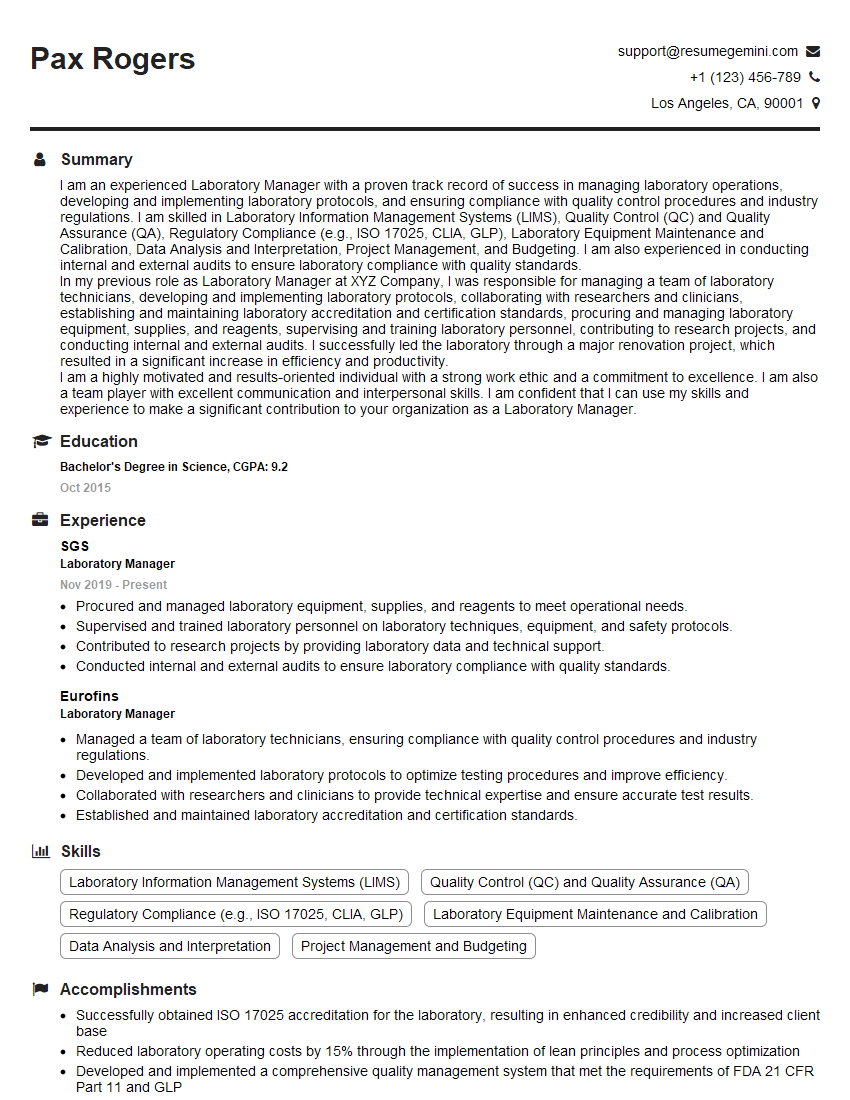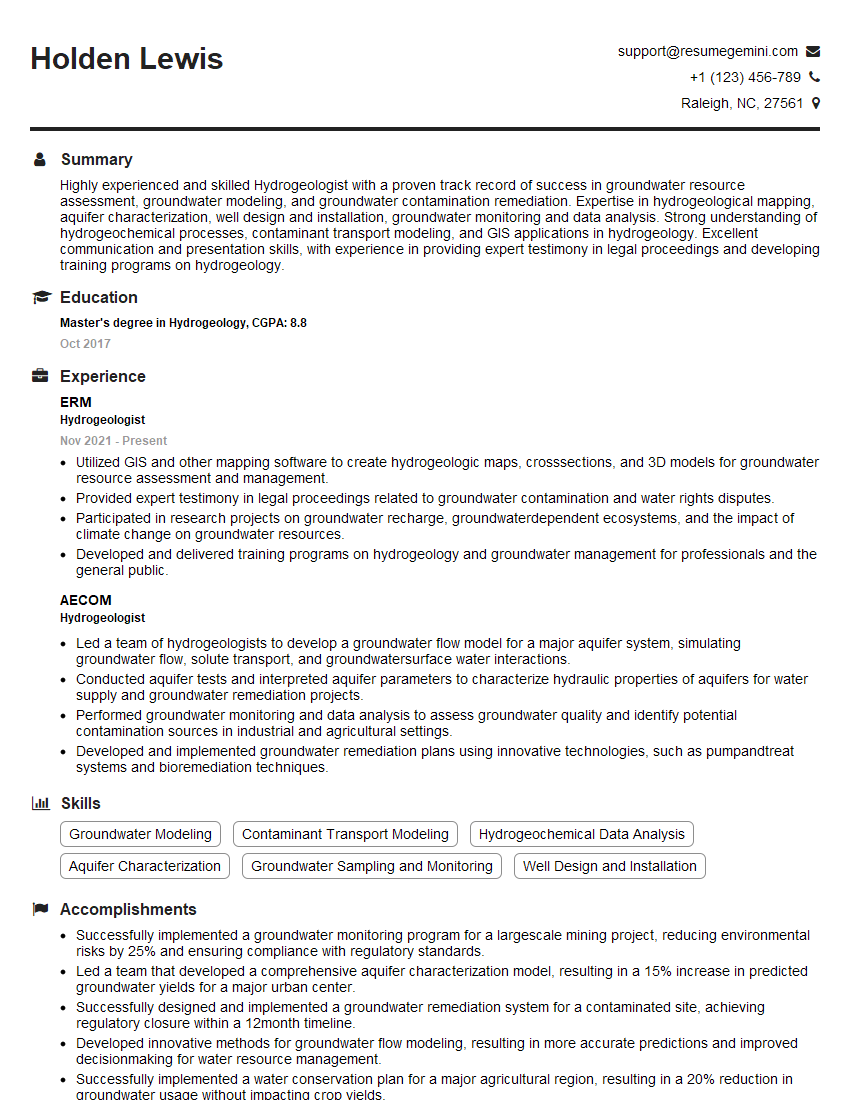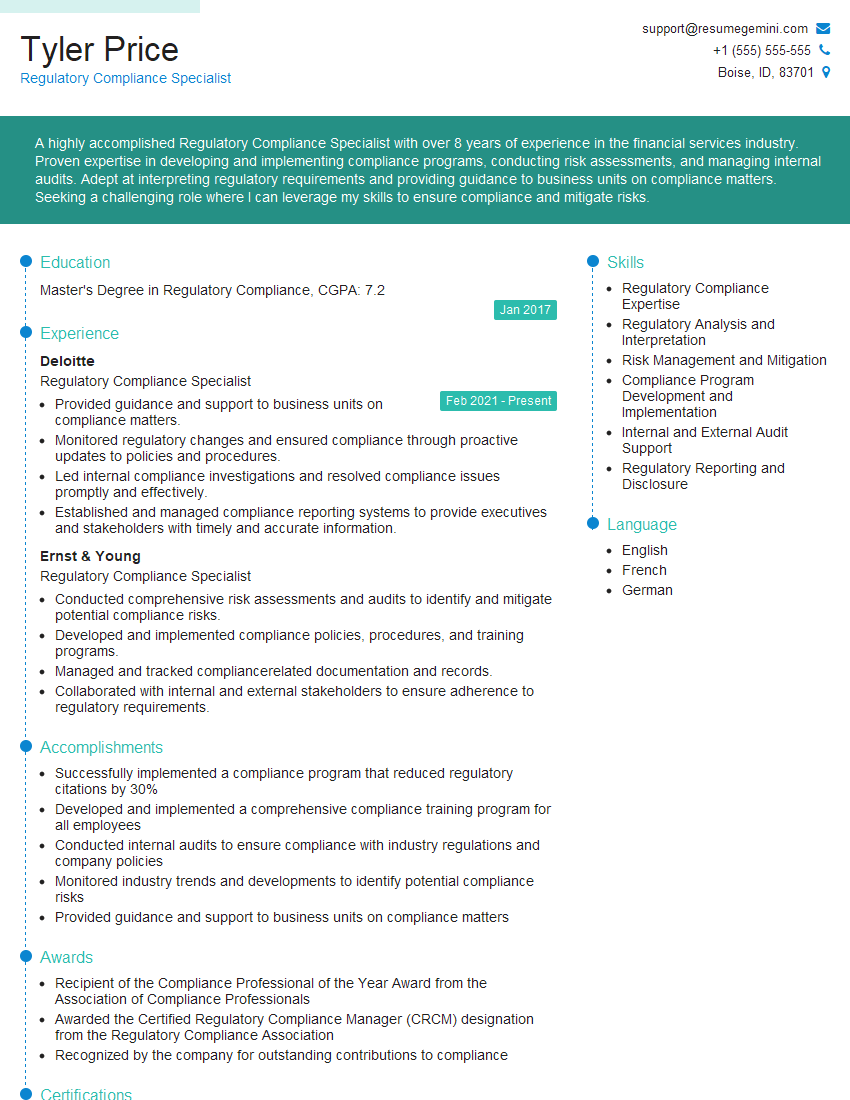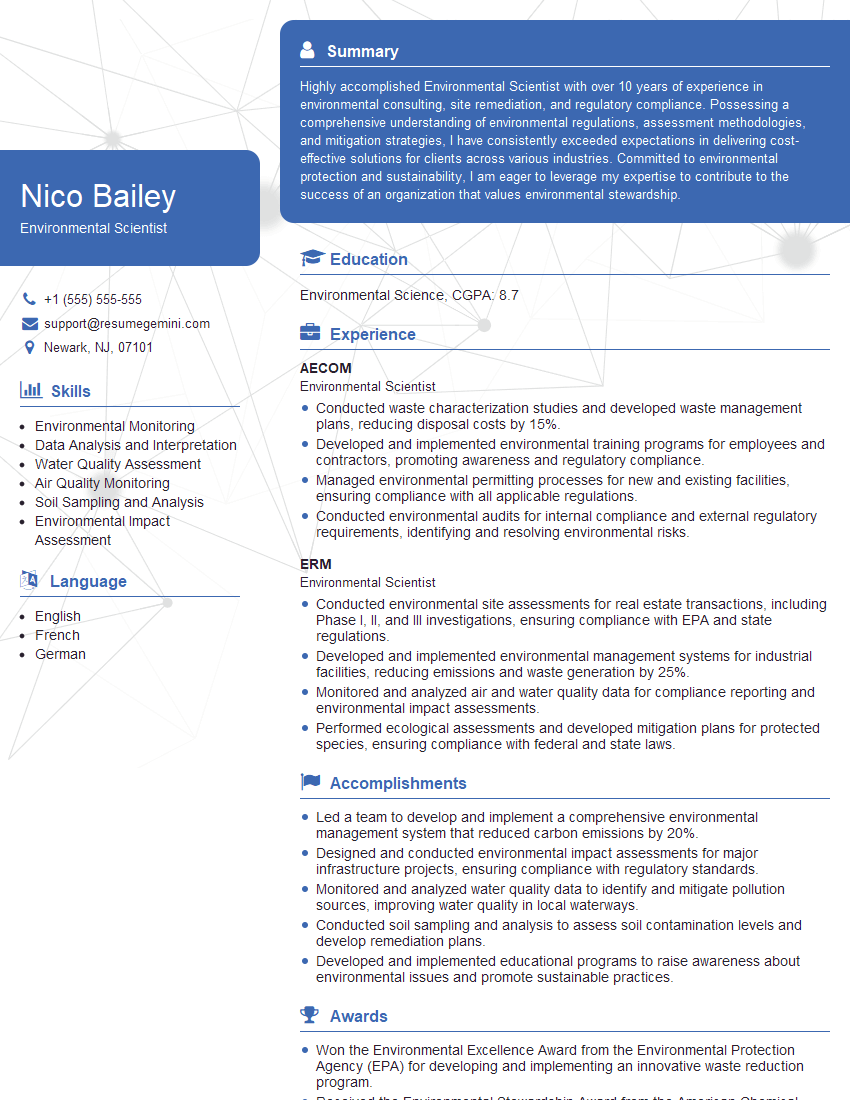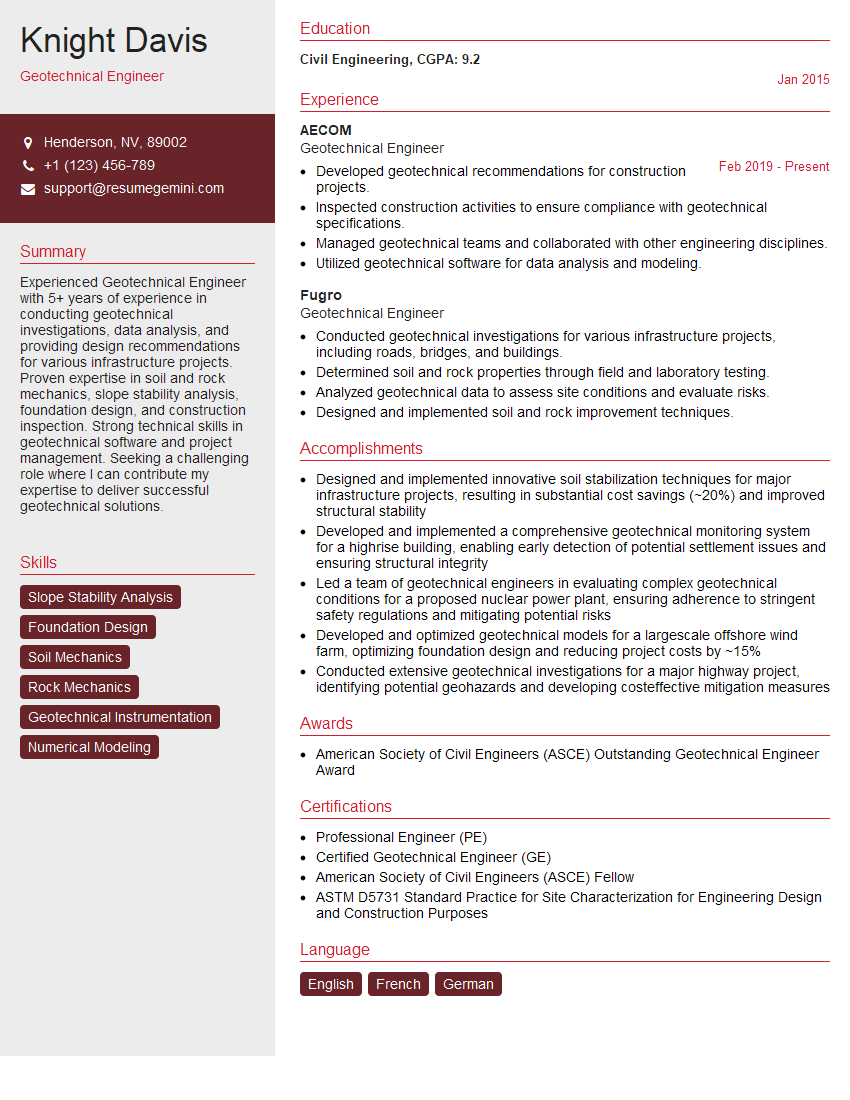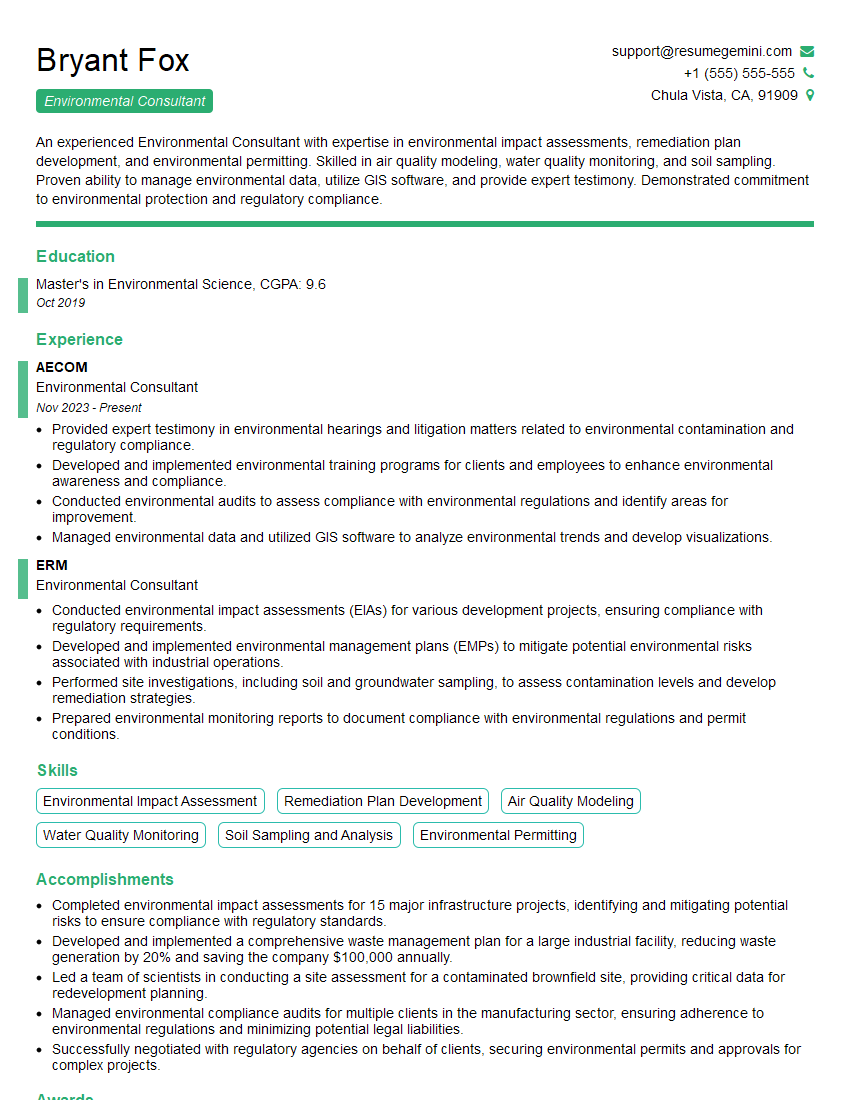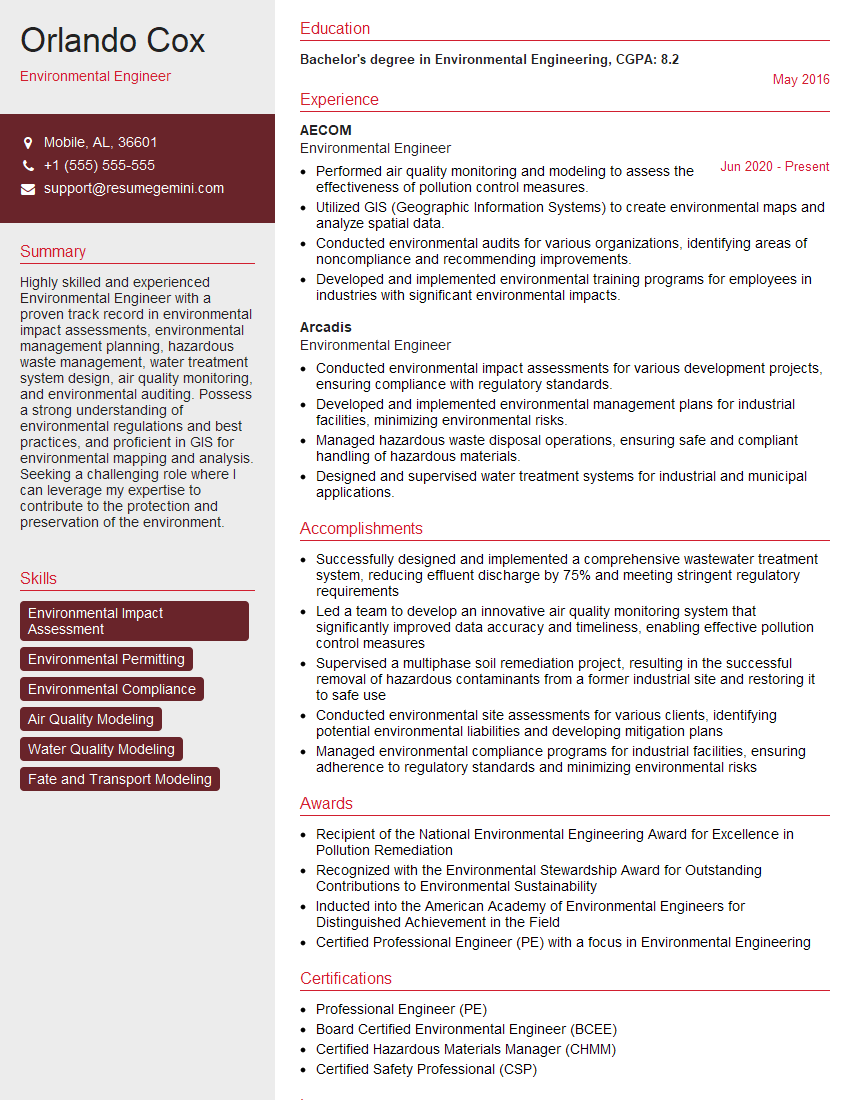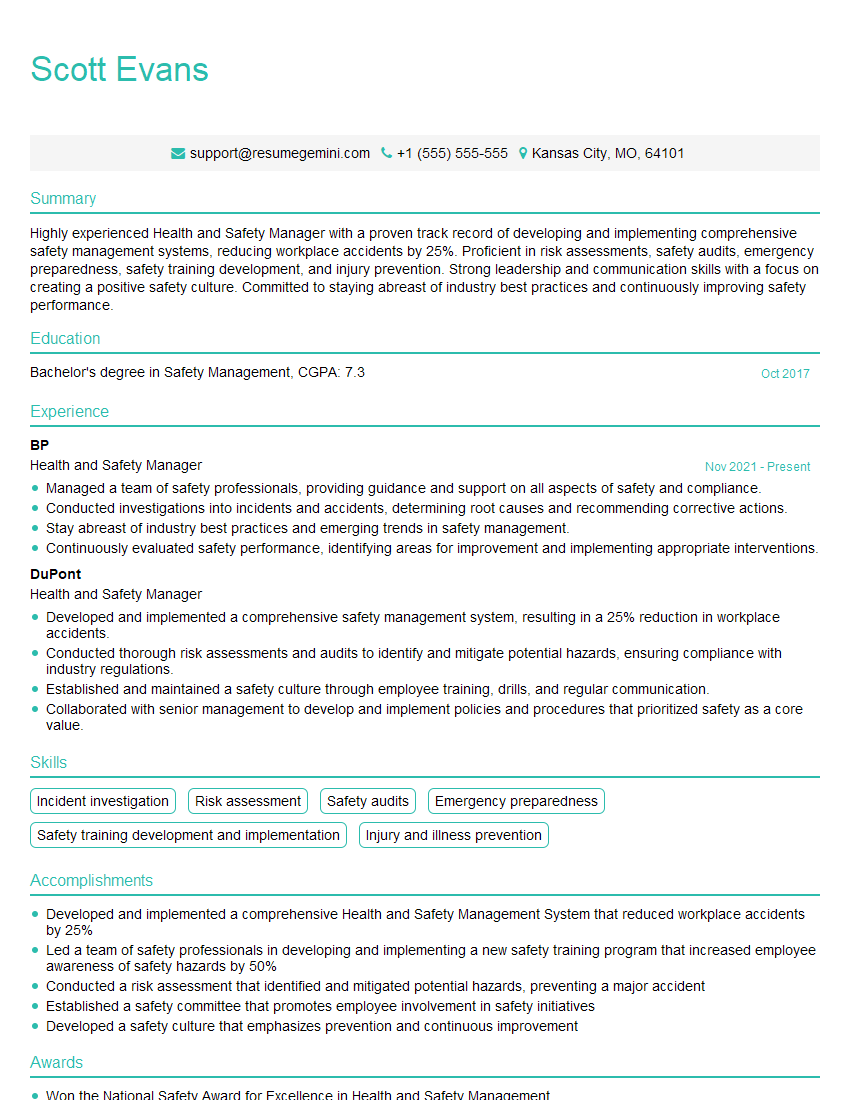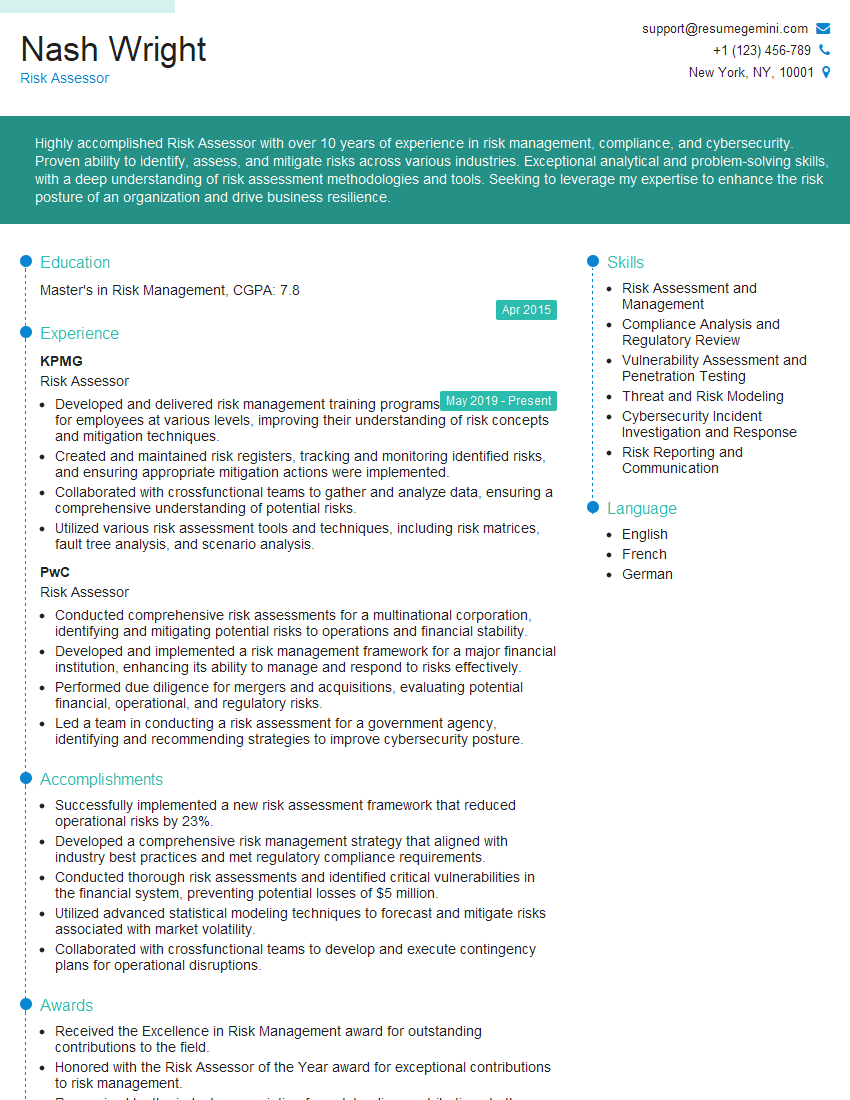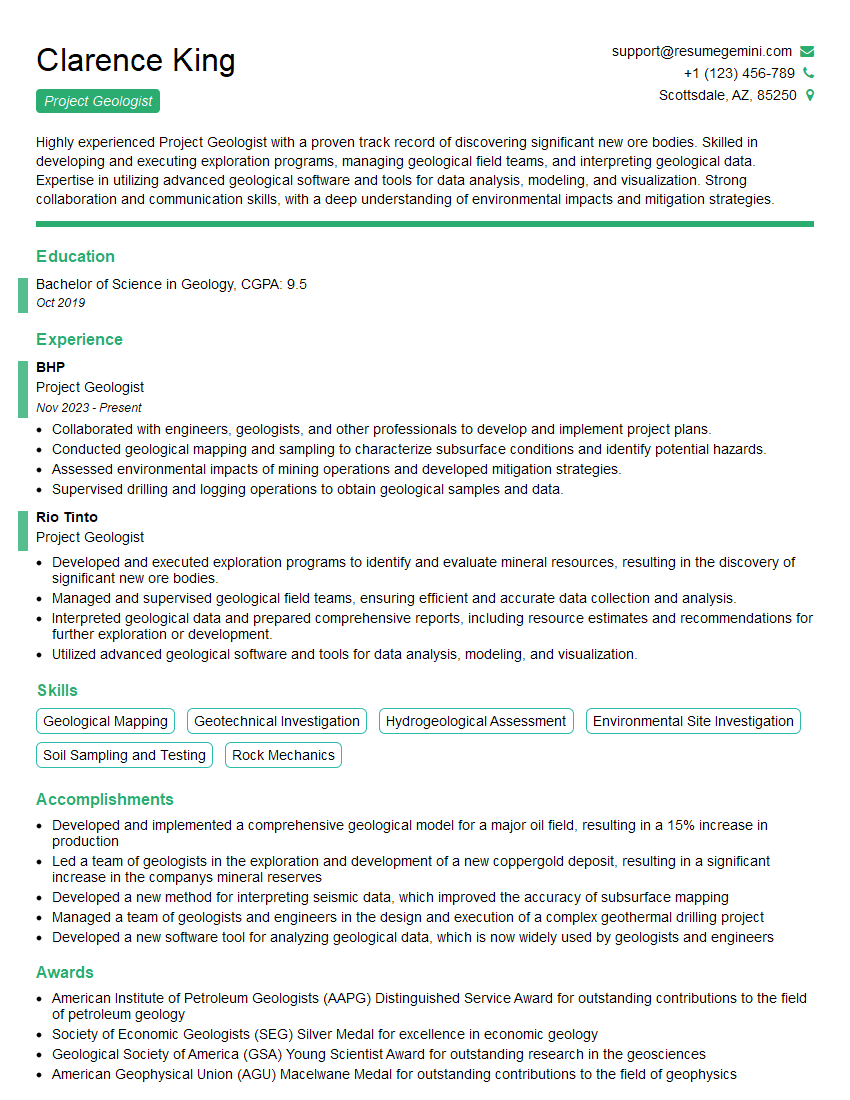Every successful interview starts with knowing what to expect. In this blog, we’ll take you through the top Contaminated Site Investigation interview questions, breaking them down with expert tips to help you deliver impactful answers. Step into your next interview fully prepared and ready to succeed.
Questions Asked in Contaminated Site Investigation Interview
Q 1. Describe the different phases of a typical contaminated site investigation.
A typical contaminated site investigation unfolds in several phases, each building upon the previous one. Think of it like peeling an onion – you start with the outer layers and progressively delve deeper to understand the contamination.
- Phase 1: Preliminary Site Assessment (PSA): This involves reviewing historical records (e.g., aerial photos, land use history, industrial activity reports), conducting site reconnaissance (visual inspection), and interviewing stakeholders to identify potential sources of contamination and areas of concern. This phase helps determine if further investigation is warranted.
- Phase 2: Site Investigation (SI): This phase involves more detailed investigation based on the findings of the PSA. It includes soil and groundwater sampling, geophysical surveys (e.g., ground-penetrating radar), and potentially the collection of samples from other media such as sediment or surface water. The goal is to define the nature and extent of contamination.
- Phase 3: Remedial Investigation (RI): If contamination is confirmed, a RI is conducted to characterize the contamination in greater detail. This involves more extensive sampling and analysis to assess the mass and volume of contaminants, their pathways of migration, and potential risks to human health and the environment. This phase informs remediation strategies.
- Phase 4: Remedial Action (RA): Based on the RI, a remediation plan is developed and implemented to remove or contain the contamination. This could involve excavation, pump-and-treat systems, bioremediation, or other techniques. Monitoring is crucial to ensure the effectiveness of the remediation.
- Phase 5: Post-Remediation Monitoring (PRM): After remediation, PRM is conducted to verify the effectiveness of the cleanup and ensure that contaminant levels remain below regulatory limits. This often involves regular sampling and analysis over a specified period.
For example, imagine a former gas station. The PSA might reveal old underground storage tanks. The SI would confirm the presence of petroleum hydrocarbons in the soil and groundwater. The RI would quantify the extent and the RA would involve excavation and soil replacement.
Q 2. Explain the process of identifying potential sources of contamination.
Identifying potential sources of contamination requires a systematic approach. It’s like detective work, piecing together clues to find the culprit.
- Historical Records Review: Examining historical maps, deeds, aerial photographs, industrial records, and environmental permits can reveal past activities that may have caused contamination. For instance, old maps might show the location of former landfills or industrial plants.
- Site Reconnaissance: A visual inspection of the site identifies obvious signs of contamination, such as staining in the soil, the presence of drums or debris, or unusual vegetation. A thorough walk-around is essential.
- Interviews with Stakeholders: Talking to current and former owners, operators, employees, and residents can provide valuable information about past activities and potential sources of contamination. Their memories and experiences can be critical.
- Geophysical Surveys: Techniques like ground-penetrating radar (GPR) can detect subsurface anomalies, such as buried tanks or waste disposal areas, which are potential sources of contamination.
Consider a site with suspected past industrial use. Reviewing historical documents might reveal the manufacture of chemicals. Site reconnaissance might uncover buried piping. Interviews with former workers could confirm the disposal of waste onsite. Combining these methods provides a comprehensive picture of potential sources.
Q 3. What are the key regulatory requirements for contaminated site investigations in your region?
Regulatory requirements for contaminated site investigations vary by region and jurisdiction. However, common elements generally include compliance with environmental protection acts and regulations, adhering to established sampling and analytical methods, and proper documentation of all procedures. Specific regulations often dictate acceptable levels of contaminants in soil and groundwater (often referred to as ‘cleanup goals’ or ‘risk-based cleanup levels’).
In many regions, responsible parties are required to report contamination, conduct investigations, and undertake remediation. Failure to comply can lead to significant penalties including fines, and legal action. It’s crucial to consult with relevant environmental agencies to understand the specific regulatory framework for a given project and to ensure compliance throughout the investigation process.
For example, a specific region might have stringent regulations concerning the cleanup of volatile organic compounds (VOCs) near a drinking water source, requiring more rigorous sampling and remediation techniques than in a less sensitive area.
Q 4. How do you determine the extent of contamination in soil and groundwater?
Determining the extent of contamination involves a combination of sampling, analysis, and interpretation. Imagine trying to find the edges of an oil spill – you need to sample systematically to define the boundaries.
- Soil Sampling: Samples are collected at various depths and locations across the site using techniques such as hand augering, direct push technology, or drilling. The spatial distribution of contaminants is mapped using a Geographic Information System (GIS).
- Groundwater Sampling: Monitoring wells are installed to collect groundwater samples at various depths. The location and depth of monitoring wells are strategically chosen to capture the full extent of groundwater contamination.
- Data Analysis and Interpretation: Laboratory results are used to create concentration maps (isopleths) showing the spatial distribution of contaminants. Statistical methods are used to estimate the extent and volume of contamination.
A common scenario involves a plume of groundwater contamination. By strategically placing monitoring wells, we can track the plume’s boundaries. Statistical analyses help determine how far the contamination extends beyond the sampled points.
Q 5. What sampling methods are appropriate for different types of contaminants?
The choice of sampling method depends on the type of contaminant, the medium (soil, groundwater, etc.), and the investigation objectives. Different contaminants behave differently, requiring tailored approaches.
- Volatile Organic Compounds (VOCs): VOCs require special techniques to prevent their loss during sampling and handling. Purged and vacuumed well systems are often used for groundwater, while soil samples are collected in sealed containers.
- Semi-Volatile Organic Compounds (SVOCs): SVOCs are less volatile and can be sampled using standard soil and groundwater techniques, but care is still needed to minimize loss during handling and analysis.
- Metals: Metals are typically bound to soil particles and can be sampled using standard soil sampling techniques. Groundwater samples are analyzed for dissolved and particulate metal concentrations.
- Pesticides and Herbicides: These compounds often require specific extraction and analysis techniques because of their varying physical and chemical properties.
For example, sampling for VOCs in groundwater might involve using specialized bailers or pumps to minimize air contact. Conversely, collecting soil samples for metals might use a simple auger, since metals are relatively immobile in soil.
Q 6. Explain the importance of chain of custody procedures.
Chain of custody (COC) procedures are critical to ensure the integrity and reliability of environmental samples. It’s a documented trail that tracks the movement and handling of a sample from collection to analysis and beyond. Think of it as a detailed passport for your sample.
A proper COC documents each step of the sampling process, including the date and time of collection, the sample location, the person who collected the sample, and all subsequent handlers. Any changes in sample custody must be documented, including transfer from the field to the lab and from one analyst to another. Breaks in the COC can compromise the admissibility of evidence in regulatory settings or legal disputes.
A complete and unbroken COC is essential to demonstrate that the samples analyzed are indeed representative of the site conditions and have not been compromised or tampered with. It is a crucial component in maintaining data quality and defending the conclusions of the investigation.
Q 7. How do you interpret analytical laboratory results?
Interpreting analytical laboratory results requires a thorough understanding of the data and its context. It’s not just about looking at numbers; it’s about understanding what those numbers mean in relation to the site and regulatory requirements.
- Comparison with Regulatory Standards: The most important step is comparing the analytical results to relevant regulatory standards or cleanup goals. This determines whether the detected concentrations exceed acceptable limits.
- Data Quality Assessment: Assessing data quality is crucial. This involves evaluating the accuracy and precision of the analytical results, including checking for any potential errors or contamination during sampling and analysis.
- Spatial and Temporal Trends: Analyzing spatial and temporal trends in contaminant concentrations helps understand the extent and potential migration pathways of contamination. Are concentrations higher in specific areas? Are they changing over time?
- Data Visualization: Creating maps and graphs of the data makes it easier to visualize the spatial distribution and temporal trends in contaminant concentrations.
For example, if the detected concentration of a specific contaminant exceeds the regulatory standard, it indicates the need for further investigation or remediation. However, if the data shows a decline in concentrations over time, it may suggest the effectiveness of natural attenuation processes.
Q 8. What are the common methods used for remediation of contaminated sites?
Remediation of contaminated sites involves a range of techniques aimed at reducing or eliminating contaminants to acceptable levels. The choice of method depends heavily on the type and extent of contamination, the site’s characteristics, and regulatory requirements. Common methods fall into several categories:
- Excavation and Disposal: This involves digging up contaminated soil or sediment and transporting it to a licensed disposal facility. This is effective for localized, high-concentration contamination. Example: Removing contaminated soil from a former gas station.
- In-situ Treatment: These techniques treat the contamination where it is located, minimizing excavation. Examples include:
- Bioremediation: Using microorganisms to break down contaminants. Example: Accelerating the natural degradation of petroleum hydrocarbons using oxygen and nutrients.
- Chemical Oxidation: Using chemicals to break down or transform contaminants. Example: Using persulfates to oxidize chlorinated solvents.
- Soil Vapor Extraction (SVE): Removing volatile contaminants from the soil using vacuum. Example: Removing volatile organic compounds (VOCs) from a former dry cleaner site.
- Air Sparging: Injecting air into groundwater to volatilize contaminants for subsequent removal. Example: Treating VOC plumes in groundwater.
- Pump and Treat: Extracting groundwater, treating it to remove contaminants, and then returning the cleaned water to the aquifer. Example: Removing dissolved metals from groundwater.
- Phytoremediation: Using plants to absorb or stabilize contaminants. Example: Using plants to uptake heavy metals from contaminated soil.
- Solidification/Stabilization: Binding contaminants within a solid matrix to prevent migration. Example: Treating heavy metal contaminated soil by mixing with cement.
The selection of the optimal remediation strategy often involves a combination of these methods for maximum effectiveness and cost-efficiency.
Q 9. Describe your experience with risk assessment methodologies.
Risk assessment is crucial in contaminated site investigations. My experience encompasses a range of methodologies, primarily following the established framework of hazard identification, dose-response assessment, exposure assessment, and risk characterization. I’m proficient in using quantitative and qualitative approaches.
For hazard identification, we utilize site history, sampling data, and existing environmental reports to determine the presence and nature of contaminants. Dose-response assessment involves evaluating the toxicity of contaminants and their potential health effects based on established toxicological data (e.g., EPA guidelines). Exposure assessment focuses on how people or the environment might come into contact with these contaminants – through inhalation, ingestion, or dermal contact. We consider exposure pathways, duration, and frequency. Finally, risk characterization combines the information from the previous steps to estimate the overall risk, often expressing it as a probability of adverse health effects or ecological damage.
I have experience using various risk assessment software packages and models, customizing them according to the specific needs of each project. For example, in a recent project involving a former industrial site, we used a probabilistic risk assessment model to account for uncertainties in contaminant concentrations and exposure scenarios, providing a more realistic estimate of potential risks. This allowed us to justify and prioritize remediation actions effectively.
Q 10. How do you develop a remediation plan?
Developing a remediation plan is an iterative process that requires careful consideration of various factors. It typically involves these steps:
- Site Characterization Review: Thoroughly reviewing all available data from the site investigation, including sampling results, geological information, and hydrogeological data.
- Remediation Goal Definition: Defining clear, achievable remediation goals based on regulatory requirements and risk assessment findings. This includes specifying target contaminant levels and acceptable risk levels.
- Technology Selection: Choosing appropriate remediation technologies based on factors like contaminant type and concentration, site conditions, cost-effectiveness, and potential environmental impacts. This often involves evaluating multiple options and comparing their pros and cons.
- Remediation Design: Detailing the design of the selected remediation system, including the system’s components, operational parameters, and monitoring requirements. This stage involves engineering calculations and simulations to ensure the design’s feasibility and effectiveness.
- Implementation Plan: Developing a detailed plan for implementing the remediation, including timelines, resource allocation, contractor selection, and health and safety procedures.
- Monitoring and Evaluation: Establishing a comprehensive monitoring program to assess the effectiveness of the remediation and ensure it meets the defined goals. Regular reporting and data analysis are essential.
- Closure Report: Preparing a final report documenting the entire remediation process, including results, conclusions, and recommendations. This document serves as evidence that the remediation has been successfully completed.
Throughout the process, regular communication and collaboration with stakeholders (regulators, landowners, the community) are critical for transparency and success.
Q 11. What are the key factors to consider when selecting remediation technologies?
Selecting the right remediation technology is crucial for effective and cost-efficient site cleanup. Key factors to consider include:
- Contaminant characteristics: Type, concentration, mobility, and toxicity of contaminants significantly influence technology selection. For instance, volatile organic compounds might be best addressed by soil vapor extraction, while heavy metals might require solidification/stabilization.
- Site conditions: Soil type, geology, hydrology, and climate all impact remediation effectiveness. For example, highly permeable soil might favor in-situ treatment methods, while clayey soils might require excavation.
- Cost-effectiveness: Remediation technologies vary widely in cost, considering both initial capital investment and long-term operational expenses. A cost-benefit analysis is essential to find the most economical solution.
- Regulatory requirements: Compliance with local, state, and federal regulations is mandatory. The selected technology must meet all applicable standards and receive necessary approvals.
- Environmental impact: The chosen technology should minimize potential environmental harm during and after remediation. For example, some technologies might generate secondary wastes that require proper management.
- Public acceptance: Community concerns and acceptance of the chosen technology should be taken into account. Transparency and communication are key to gaining public support.
- Remediation timeframe: Some technologies achieve faster cleanup than others. Project timelines often dictate the available choices.
Often, a combination of technologies (‘hybrid approach’) offers the most effective solution, addressing different contaminant fractions or site characteristics.
Q 12. How do you manage project budgets and timelines?
Effective budget and timeline management are vital for successful remediation projects. I employ several strategies:
- Detailed budgeting: Creating comprehensive budgets that account for all project phases, including site investigation, remediation design, implementation, monitoring, and reporting. Contingency funds are included to handle unforeseen challenges.
- Regular monitoring: Tracking expenses and progress against the budget and timeline throughout the project. This involves regular review meetings and reporting to stakeholders.
- Risk assessment and mitigation: Identifying potential budget and schedule risks early on and implementing strategies to mitigate them. This includes contingency planning for potential delays or cost overruns.
- Value engineering: Evaluating alternative solutions and technologies to optimize cost-effectiveness without compromising project goals. This involves analyzing trade-offs between cost, efficiency, and environmental impact.
- Effective communication: Maintaining open communication with stakeholders to keep them informed of budget and schedule changes and to address any concerns promptly.
- Change management: Developing clear procedures for managing changes to the project scope, budget, or timeline. This helps maintain project control and prevent scope creep.
I use project management software to track progress, manage tasks, and generate reports. My experience demonstrates consistent success in meeting budget and timeline targets, while maintaining high-quality project deliverables.
Q 13. Explain your experience with data management and reporting.
Data management and reporting are fundamental to contaminated site investigations. My experience involves a systematic approach to data acquisition, processing, analysis, and reporting. This includes:
- Data acquisition: Utilizing various methods such as field sampling, laboratory analysis, and data collection from existing sources. Ensuring data quality and chain of custody are paramount.
- Data processing: Using software tools to manage and process large datasets, ensuring data integrity and consistency. This often includes data validation, cleaning, and transformation.
- Data analysis: Employing statistical methods and visualization techniques to interpret data, identify trends, and draw meaningful conclusions. This allows us to develop risk assessments and support remediation strategies.
- Data reporting: Preparing clear, concise, and accurate reports that communicate findings to stakeholders. This includes creating figures, maps, and tables to visually represent the data. These reports often follow specific regulatory guidelines.
- Data storage and archiving: Implementing secure and organized systems for storing and archiving all project data, ensuring easy access and retrieval.
I have experience with various database management systems and software packages for statistical analysis and data visualization. I prioritize a transparent and auditable data management system, ensuring data quality and consistency throughout the project lifecycle.
Q 14. Describe your experience with using GIS software in contaminated site investigations.
Geographic Information Systems (GIS) software is invaluable in contaminated site investigations. I’m proficient in using GIS software (ArcGIS, QGIS) to manage, analyze, and visualize spatial data. This includes:
- Creating site maps: Developing detailed maps of the investigation area, incorporating topographical features, sampling locations, contaminant plumes, and other relevant spatial data.
- Data integration: Integrating data from various sources (e.g., sampling data, geological maps, aerial photography) into a GIS environment to create a comprehensive spatial database.
- Spatial analysis: Using GIS tools to perform spatial analysis tasks such as interpolation, proximity analysis, and overlay analysis to understand the spatial extent and distribution of contaminants.
- Visualization and communication: Creating maps and other visual representations of spatial data to effectively communicate findings to stakeholders. This allows for clear communication of complex information, supporting decision-making for remediation.
- Modeling and simulation: Using GIS in conjunction with other models (e.g., groundwater flow models) to simulate contaminant transport and predict future plume behavior.
For example, in a recent project, we used GIS to create interactive maps that showed the spatial distribution of soil contamination, helping to optimize sampling locations and design a more effective remediation strategy. The resulting maps facilitated clear communication with regulatory agencies and the community, enhancing transparency and collaboration.
Q 15. How do you communicate technical information to non-technical audiences?
Communicating complex technical information to non-technical audiences requires careful planning and a clear understanding of the audience’s knowledge base. I start by identifying the key takeaways – what information is absolutely essential for them to understand? Then, I translate technical jargon into plain language, using analogies and visual aids wherever possible. For example, instead of saying ‘the soil exhibited elevated levels of TPH,’ I might say ‘we found more oil than is safe in the soil.’ I also break down complex concepts into smaller, more manageable chunks, using simple charts, graphs, or even storytelling to illustrate my points. Finally, I always encourage questions and ensure I’m checking for understanding throughout the communication process.
For instance, when presenting findings to a community group concerned about a contaminated site, I would avoid terms like ‘permeable reactive barrier’ and instead focus on the practical implications – ‘this method cleans the groundwater, making it safer for drinking and use.’ I might use a diagram showing how the groundwater flows and how the barrier works to improve comprehension.
Career Expert Tips:
- Ace those interviews! Prepare effectively by reviewing the Top 50 Most Common Interview Questions on ResumeGemini.
- Navigate your job search with confidence! Explore a wide range of Career Tips on ResumeGemini. Learn about common challenges and recommendations to overcome them.
- Craft the perfect resume! Master the Art of Resume Writing with ResumeGemini’s guide. Showcase your unique qualifications and achievements effectively.
- Don’t miss out on holiday savings! Build your dream resume with ResumeGemini’s ATS optimized templates.
Q 16. What are your experiences with different types of soil and groundwater contamination?
My experience encompasses a wide range of soil and groundwater contamination scenarios. I’ve worked on sites with petroleum hydrocarbon contamination from leaking underground storage tanks (LUST), where the contaminants tend to be found in the soil and shallow groundwater. In other projects, I’ve dealt with chlorinated solvents, like trichloroethylene (TCE), which are denser than water and can sink deep into the aquifer, requiring more complex investigation and remediation strategies. I’ve also investigated sites impacted by heavy metals, such as lead and arsenic, often originating from industrial activities, and sites contaminated by pesticides and herbicides from agricultural runoff. Each type of contaminant requires a unique sampling and analytical approach, tailored to its specific properties and behavior in the environment. For example, the sampling strategy for volatile organic compounds (VOCs) like TCE would involve specialized equipment to minimize sample loss during collection and analysis, whereas sampling for heavy metals would focus on obtaining representative samples from different soil layers.
Q 17. How do you address uncertainties and data gaps in site investigations?
Addressing uncertainties and data gaps is a crucial aspect of contaminated site investigation. We use a variety of methods to manage this. First, we thoroughly review existing data, looking for patterns and clues that might help fill the gaps. Secondly, we utilize various techniques like statistical analysis to estimate unknown parameters based on the available data. This might involve interpolating data points to create a more complete picture of contamination. Thirdly, we employ a phased approach to investigation. This means we may start with a less expensive and less intrusive investigation phase to gain preliminary information, which will then help us plan a more targeted and comprehensive investigation phase to address the remaining uncertainties. Finally, and critically, we clearly document all assumptions, uncertainties, and limitations of the available data in our reports, allowing decision-makers to understand the context of the findings. This transparency is paramount for informed decision-making.
For example, if soil sampling reveals contamination in only one area of a larger site, we might conduct additional sampling at increasing distances to delineate the extent of the contamination plume. If we have limited historical data, we’ll rely on professional judgment and modeling to estimate the possible extent and type of contamination, all while acknowledging the inherent uncertainties in our conclusions.
Q 18. Describe your experience with environmental regulations (e.g., CERCLA, RCRA).
I have extensive experience with environmental regulations, including the Comprehensive Environmental Response, Compensation, and Liability Act (CERCLA) and the Resource Conservation and Recovery Act (RCRA). My understanding of these regulations allows me to design and execute site investigations that comply with all applicable rules and regulations. Under CERCLA, I understand the importance of conducting thorough site characterizations to identify responsible parties and determine the appropriate remedial action. Under RCRA, I’m familiar with the regulations related to the management of hazardous waste, including the proper procedures for sampling, analysis, and reporting. I also understand the nuances of state-specific regulations, which often overlap with federal requirements. This ensures that my projects are not only environmentally sound but also legally compliant.
For example, in a CERCLA site investigation, I would ensure that all sampling and analytical data adhere to EPA guidelines, document all findings accurately, and maintain detailed chain-of-custody records to establish the validity of the data. When dealing with RCRA-regulated hazardous waste, I would follow the strict protocols for handling, storage, and disposal to prevent potential environmental and health risks.
Q 19. How do you ensure the safety of personnel during site investigations?
Ensuring personnel safety is always my top priority. Before any field work begins, a thorough site safety plan (SSP) is developed, addressing potential hazards at the site. This includes identifying potential risks like the presence of hazardous materials, confined spaces, excavation hazards, and risks associated with the specific sampling equipment used. The SSP outlines specific safety procedures and control measures, such as proper personal protective equipment (PPE), safety training for all personnel, emergency response protocols, and regular safety meetings. We also conduct regular site inspections to ensure that all safety procedures are being followed. Communication is also crucial; everyone on the team is kept informed of potential hazards and any changes in site conditions. Detailed incident reporting protocols are also in place to track and learn from any near misses or accidents. We also use air monitoring equipment for various potential contaminants during sampling activities to ensure safe exposure levels.
Q 20. What are your experiences with different types of sampling equipment?
My experience with sampling equipment is extensive and includes a wide variety of tools for soil and groundwater sampling. For soil sampling, I’ve utilized techniques ranging from hand augers for shallow sampling to direct push technology for deeper investigations, as well as split-spoon samplers for obtaining undisturbed samples. For groundwater sampling, I’ve employed various methods, including the use of dedicated well points, monitoring wells with bailers and peristaltic pumps, and specialized low-flow sampling techniques. I am also familiar with the use of various in-situ probes for groundwater quality monitoring, like conductivity and oxidation-reduction potential measurements. The choice of sampling equipment depends heavily on site-specific factors like soil type, depth to groundwater, and the type of contaminants present. I always ensure the selected equipment is appropriate for the specific task, maintaining calibration and implementing proper decontamination procedures.
Q 21. How do you evaluate the effectiveness of remediation efforts?
Evaluating the effectiveness of remediation efforts is a multifaceted process. It typically involves comparing pre- and post-remediation data for soil and groundwater quality. This comparison is often expressed as a percentage reduction in contaminant concentrations. We might also use statistical analysis to test whether the observed changes are statistically significant. In addition to contaminant concentration data, we also assess other relevant indicators, such as groundwater flow patterns, the extent of contaminant plumes, and ecological indicators. Visual inspections of the site, post-remediation, might also be relevant. We use a combination of methods, such as groundwater modeling, to understand the long-term effectiveness of the remediation process. Regular monitoring after remediation is essential to ensure the long-term success and that the remediation strategies have successfully addressed the risks at the site, often for several years post-remediation.
For example, if we’re evaluating a pump-and-treat system for groundwater remediation, we’d analyze the groundwater samples over time to monitor the decline in contaminant concentrations. We’d also monitor the groundwater flow direction and the extent of the plume to see if it’s shrinking. Ultimately, remediation effectiveness isn’t just about numbers; it’s about achieving the desired environmental and human health outcomes, as defined at the beginning of the project.
Q 22. Describe your experience with site characterization techniques.
Site characterization is the cornerstone of any contaminated site investigation. It involves systematically collecting and analyzing data to define the nature and extent of contamination. This includes identifying the types of contaminants present, their concentrations, and their distribution within the environment (soil, groundwater, air).
My experience encompasses a wide range of techniques, including:
- Direct push technology: This allows for rapid and cost-effective sampling of soil and groundwater, ideal for initial site assessments.
- Soil boring and sampling: More invasive but necessary for obtaining undisturbed samples for laboratory analysis and characterizing subsurface stratigraphy.
- Groundwater monitoring well installation: Crucial for long-term monitoring of groundwater quality and assessing the plume migration of contaminants.
- Geophysical surveys: Techniques like ground-penetrating radar (GPR) and electromagnetic induction (EMI) provide non-invasive methods for identifying subsurface features and potential contaminant zones, helping optimize sampling locations.
- Laboratory analysis: This is paramount, using various methods such as gas chromatography-mass spectrometry (GC-MS) and inductively coupled plasma mass spectrometry (ICP-MS) to identify and quantify specific contaminants.
For example, on a recent project involving a suspected former gas station, we utilized direct push technology for initial screening, followed by soil boring at identified hotspots. GPR helped us map subsurface utilities and potential leachate pathways, optimizing the placement of monitoring wells. Subsequent laboratory analysis confirmed the presence of benzene and other petroleum hydrocarbons, allowing us to delineate the extent of contamination accurately.
Q 23. How do you manage project risks and potential liabilities?
Risk management in contaminated site investigation is crucial. It involves proactively identifying, assessing, and mitigating potential hazards and liabilities throughout the project lifecycle.
My approach is multi-faceted:
- Thorough initial site assessment: This includes reviewing historical records, conducting preliminary site reconnaissance, and engaging with stakeholders to identify potential risks and hazards.
- Detailed risk assessment: Employing quantitative and qualitative methods to evaluate the probability and severity of potential risks, including those related to human health, the environment, and project budget.
- Implementation of appropriate safety protocols: Adherence to all relevant health and safety regulations, using personal protective equipment (PPE), and implementing site-specific safety plans.
- Contingency planning: Developing detailed plans to address unexpected challenges or delays, such as encountering unforeseen contamination or regulatory changes.
- Comprehensive insurance coverage: Ensuring adequate insurance coverage to address potential liabilities related to environmental damage, injury, or property damage.
- Legal compliance: Strict adherence to all applicable environmental regulations and reporting requirements throughout the project.
For instance, on a site with suspected asbestos, we implemented strict protocols for asbestos handling and disposal, involving certified asbestos abatement contractors and air monitoring. This minimized the risks to workers and the environment, ensuring compliance with regulatory requirements.
Q 24. What are your strengths and weaknesses in this field?
My strengths lie in my methodical approach to problem-solving, my ability to interpret complex data, and my strong communication skills. I’m adept at translating technical information into easily understandable terms for both technical and non-technical audiences.
One area I’m constantly working to improve is my proficiency in advanced statistical modeling for contaminant transport analysis. While I have a solid understanding of the basics, enhancing my skills in this area would significantly benefit my project work.
Q 25. Explain your experience with preparing technical reports.
Preparing clear, concise, and technically accurate reports is essential for communicating findings and recommendations effectively. My experience includes drafting numerous reports for various clients, covering all aspects of contaminated site investigations from initial site assessments to remedial action plans.
My reports typically follow a standardized format, including:
- Executive summary: A concise overview of the project findings and recommendations.
- Site description: Details on the site’s location, history, and potential sources of contamination.
- Methodology: A detailed explanation of the sampling and analytical methods used.
- Results: Presentation of data in tables, figures, and maps, clearly highlighting key findings.
- Discussion: Interpretation of the results, considering the limitations and uncertainties.
- Conclusions and recommendations: Clear and actionable recommendations based on the findings.
- Appendices: Supporting documentation, including laboratory reports, chain-of-custody forms, and quality assurance/quality control (QA/QC) data.
I ensure that all reports are reviewed by senior staff members to guarantee accuracy and consistency with best practices before submission.
Q 26. How do you handle unexpected challenges or delays during a project?
Unexpected challenges are inevitable in contaminated site investigations. My approach emphasizes proactive risk management and flexible problem-solving.
When faced with unforeseen delays or challenges, I follow these steps:
- Immediate assessment: Quickly identify the nature and extent of the problem.
- Communication: Inform all stakeholders, including clients, regulatory agencies, and the project team.
- Problem-solving: Explore all viable solutions, considering their cost, time implications, and potential impact.
- Contingency plan activation: Implement the relevant components of the pre-existing contingency plan.
- Documentation: Meticulously document all changes, modifications, and resolutions.
- Lessons learned: After the event, conduct a thorough review to identify areas for improvement in future projects.
For example, encountering unexpected bedrock during drilling operations necessitated adjusting the sampling strategy. We quickly communicated the issue, revised the work plan, and employed a different drilling method to ensure project completion without significant delays.
Q 27. Describe your experience working in a team environment.
I thrive in team environments, believing that collaborative efforts yield the best results in complex projects. My experience includes working on numerous projects with diverse teams composed of geologists, hydrogeologists, engineers, chemists, and regulatory specialists.
My contributions to team success include:
- Effective communication: Clearly conveying information and actively listening to others.
- Collaboration: Working effectively with others to achieve common goals.
- Problem-solving: Contributing to brainstorming sessions and offering innovative solutions.
- Mentorship: Supporting and guiding junior team members.
- Conflict resolution: Addressing conflicts professionally and constructively.
I value open communication and mutual respect, recognizing that each team member brings unique skills and perspectives to the table. On one project, our team successfully navigated a regulatory challenge through collaborative efforts, demonstrating the power of teamwork in achieving project success.
Q 28. How do you stay up-to-date on the latest advancements in contaminated site investigation?
Staying current with advancements in contaminated site investigation is critical for providing the most effective and efficient services. I utilize several methods to stay abreast of the latest developments:
- Professional memberships: Active participation in organizations such as the American Society of Civil Engineers (ASCE) and the Association of Environmental Professionals (AEP) provides access to publications, conferences, and networking opportunities.
- Continuing education courses and workshops: Regular attendance at training sessions focused on new technologies, methodologies, and regulatory updates.
- Reviewing peer-reviewed publications: Staying informed on the latest research and findings through journals such as ‘Ground Water’ and ‘Environmental Science & Technology’.
- Industry conferences and workshops: Attending relevant conferences and workshops to learn about new technologies and best practices.
- Online resources and webinars: Utilizing online resources and webinars offered by professional organizations and industry leaders.
For instance, I recently completed a course on the application of advanced oxidation processes (AOPs) for in-situ remediation, broadening my knowledge of emerging technologies in contaminant treatment.
Key Topics to Learn for Contaminated Site Investigation Interview
- Site Reconnaissance and Preliminary Assessment: Understanding the initial steps involved in characterizing a potentially contaminated site, including historical research, site visits, and preliminary data gathering.
- Sampling Strategies and Methodologies: Developing and implementing effective sampling plans to collect representative soil, water, and air samples; understanding the various sampling techniques and their applications (e.g., soil borings, groundwater monitoring wells).
- Data Analysis and Interpretation: Proficiency in analyzing laboratory data, interpreting results, and identifying potential contaminants and their concentrations. This includes understanding data quality objectives (DQOs) and uncertainty analysis.
- Regulatory Compliance and Reporting: Familiarity with relevant environmental regulations and guidelines (e.g., CERCLA, RCRA); understanding the requirements for preparing comprehensive site investigation reports and communicating findings to regulatory agencies.
- Remediation Technologies: Knowledge of various remediation technologies used to address contaminated sites (e.g., excavation, pump and treat, bioremediation); ability to evaluate the suitability of different technologies based on site-specific conditions.
- Risk Assessment and Management: Understanding the principles of risk assessment, including exposure pathways and human health risk assessment; ability to develop risk management plans to mitigate potential hazards.
- Health and Safety Procedures: Knowledge and application of safe work practices in contaminated site investigation, including personal protective equipment (PPE) and emergency response protocols.
- GIS and Data Management: Proficiency in using Geographic Information Systems (GIS) software to manage and visualize site data; understanding data management principles for efficient organization and retrieval of information.
- Problem-Solving and Critical Thinking: Demonstrating the ability to analyze complex situations, interpret data, and develop effective solutions to environmental challenges; showcasing problem-solving skills through case studies or projects.
Next Steps
Mastering Contaminated Site Investigation opens doors to a rewarding career with significant growth potential in environmental consulting, remediation, and regulatory agencies. To maximize your job prospects, creating a strong, ATS-friendly resume is crucial. ResumeGemini is a trusted resource that can help you build a professional resume that showcases your skills and experience effectively. Examples of resumes tailored to Contaminated Site Investigation are available to guide you through the process.
Explore more articles
Users Rating of Our Blogs
Share Your Experience
We value your feedback! Please rate our content and share your thoughts (optional).
What Readers Say About Our Blog
Hi, I have something for you and recorded a quick Loom video to show the kind of value I can bring to you.
Even if we don’t work together, I’m confident you’ll take away something valuable and learn a few new ideas.
Here’s the link: https://bit.ly/loom-video-daniel
Would love your thoughts after watching!
– Daniel
This was kind of a unique content I found around the specialized skills. Very helpful questions and good detailed answers.
Very Helpful blog, thank you Interviewgemini team.
